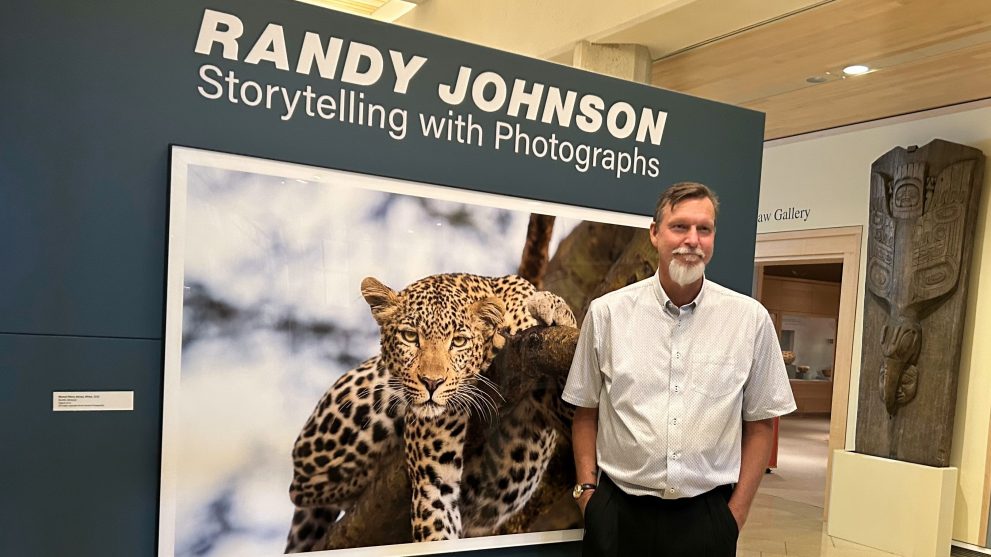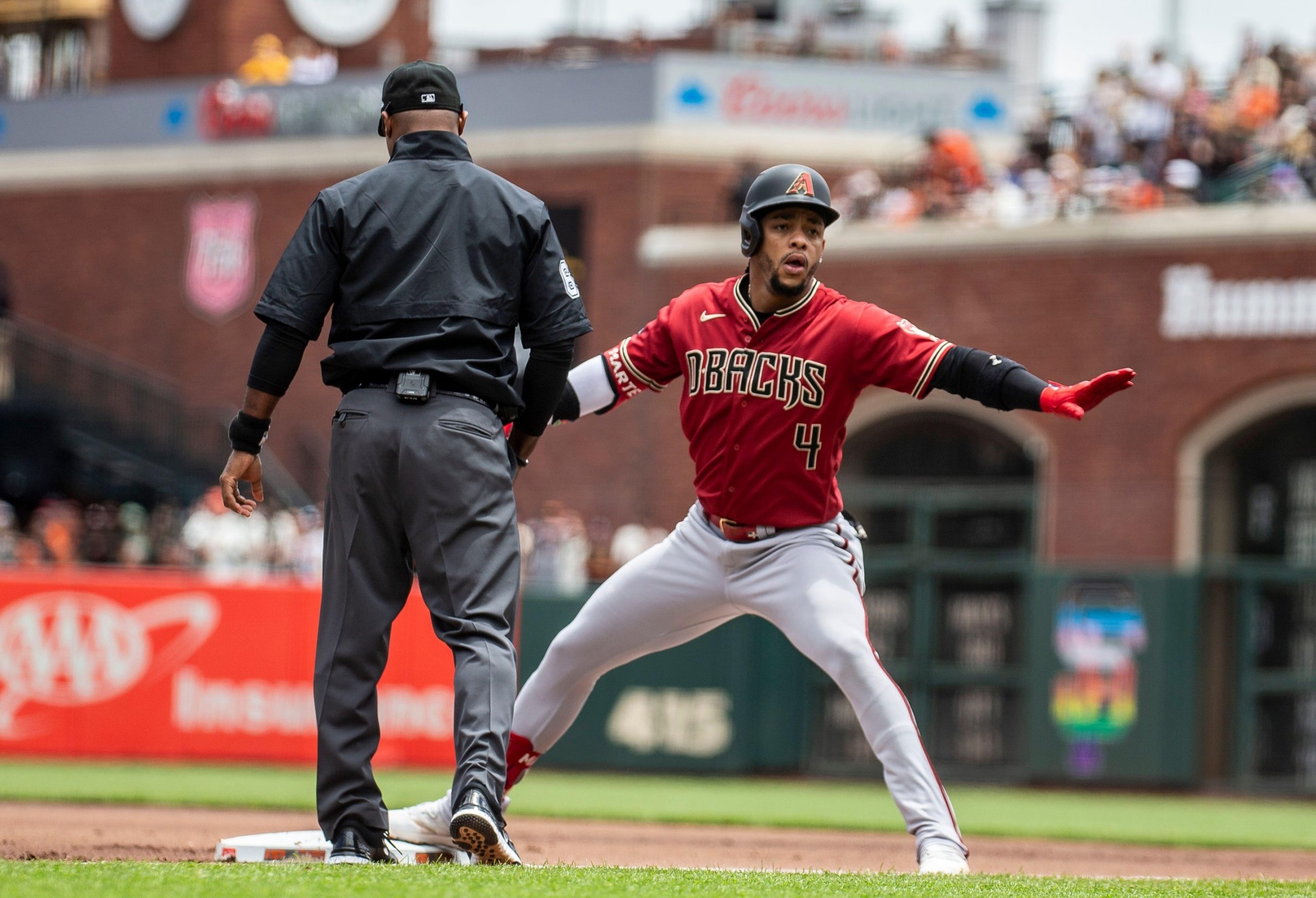COOPERSTOWN, N.Y. — One of the most intimidating pitchers in baseball history stood inside the Fenimore Art Museum last Saturday morning and looked confident, if a smidge nervous.
“This is my first photography exhibit,” Randy Johnson said.
Yes. That Randy Johnson — the snarling, mullet-sporting, 6-foot-10 left-hander who won 303 games and struck out 4,875 batters, second-most behind only Nolan Ryan, with a frightening combination of a triple-digit fastball and a wipeout slider.
The long hair is long gone, joined comfortably in Johnson’s rearview mirror by his baseball exploits. Told during a brief post-exhibit interview with Compare.bet that he’s the Arizona Diamondbacks’ all-time leader in WAR, Johnson offered a wry grin and said “I don’t even know what WAR is, I really don’t.”
Getting to spend 20 minutes this morning listening to Randy Johnson talk about his passion for photography and his exhibit at the Fenimore Art Museum in Cooperstown was super cool.
(Not pictured: His mortal enemy Ned Flanders) pic.twitter.com/H7nd1YRE22
— Jerry Beach (@JerryBeach73) July 22, 2023
But Johnson understands his Hall of Fame career — he received 97.3 percent of the vote, the 11th-highest in history, upon earning first-ballot enshrinement in 2015 — has afforded him the opportunity to travel the world partaking in a passion that began in college, when he majored in photojournalism at USC and took concert photos for the campus paper.
His status as a well-known player also ensures a built-in audience for his photography. The Fenimore, located fewer than two miles from the Hall of Fame, is displaying “Randy Johnson: Storytelling Through Photographs” — 30 prints from his collection of photos he’s taken in Africa — through the end of the year, more than three months longer than originally planned.
Johnson spent 20 minutes addressing a dozen or so reporters in town to cover the Hall of Fame Induction Weekend as well as some patrons taking a well-timed stroll through the gallery — one of whom said she was in attendance for Johnson’s perfect game in Atlanta on May 18, 2004 and told him she forgave him for twirling the gem against her favorite team.
“He’s off to a great start — hopefully he plays 10, 15, 20 more years. You can never foresee injuries or anything like that, but right now, he’s dynamite.
“It’s nice that the Diamondbacks have a franchise player. And Corbin Carroll is that.”https://t.co/n9XgJizJhT
— Kyle Odegard (@Kyle_Odegard) July 27, 2023
Johnson’s website and Instagram account are both named RJ51photos, a homage to his uniform number. His photography logo is a dead bird, an acknowledgment of his oddest on-field moment.
But as Johnson nears his 60th birthday, he wants to be known as an inquisitive, appreciative and improving photographer, looking ahead to shooting the perfect picture instead of looking back at his perfect game.
“I’ve learned a lot from various photographers, sports photographers, wildlife photographers,” said Johnson, whose ID badge listing him as a Hall of Fame member hung around his neck. “And if I don’t have conversations with them, personally, like I’m having with you — I may just reach out to them and text them or something like that. I’m not afraid to learn. And I think there’s a great deal of parallels between pitching and photography.”
Johnson refined his mechanics with fellow late bloomer Ryan in 1992 and went 254-118 with a 3.13 ERA and 4,057 strikeouts over his final 17 seasons.
“I did that frequently, or I watched other pitchers that I admired,” Johnson said. “It’s the same thing with photography. I wonder how they went about putting that photo together. And in some cases, I’m lucky enough to actually talk to the photographer and get insight and knowledge.”
Photography offers a glimpse at a more relaxed Johnson, who had an air of intimidation even when he wasn’t on the mound or preparing to pitch. Capturing just the right shot requires patience that is hard to display when engaged in the one-on-one duel from 60 feet, six inches away.
“Animals are extremely difficult to take pictures of — unpredictable, they could be sleeping, you can’t stop them and tell them to ‘Go back, I missed a picture, can you smile?’” Johnson said with a grin.
When overseas, he said he asks for permission to take pictures of his human subjects before compensating them.
“Just don’t walk up and stick my camera in their faces — I know better than that,” Johnson said with another grin.
Jan. 10, 2005: Randy Johnson arrives in New York after signing with Yankees and immediately pushes a cameraman #ThisDayInGIFs pic.twitter.com/utA9DPeTpN
— New York Post Sports (@nypostsports) January 10, 2017
The New Yorkers in the audience chuckled, recalling his run-in with a tabloid photographer trying to take Johnson’s picture as he exited a Manhattan hotel on his way to his introductory press conference with the Yankees in 2005.
One of Johnson’s favorite photos pictures three adolescent-aged Ethiopian boys, adorned in face paint and standing on the stilts they’d constructed.
“They’re in a main part of town that tourists come through and they’re on the side of the road and who wouldn’t want to stop when you see something like that?” Johnson said. “And you give them five, 10 bucks and they’re happy as heck and then they wait for the next group of people to come.
“And I’m happy because I get something that is very interesting and unique and I can share it with people like yourself or put it on my social media. And they’re happy because they do live in a culture that’s not quite as up-to-date as up here. So they’re helping me out and I like to think that I’m doing the same.”
Johnson plans to visit Ethiopia again in September — a trip for which he will be as prepared as he was for any of his 618 appearances on a big league mound. In addition to doing his usual pre-trip research, Johnson will be working with an Ethiopian-based photographer guide who can better advise him during their trip.
As was the case when he was a pitcher, the preparation guarantees nothing. But without it, perfection will be impossible to attain.
May 18, 2004: 40-year old Randy Johnson throws a perfect game in Atlanta pic.twitter.com/cnCo2Kq8n6
— This Day In Sports Clips (@TDISportsClips) May 18, 2020
“My best game that I ever pitched was the perfect game — I was 40 years old, go figure,” Johnson said. “The bottom line is I’m always striving to be a better pitcher and that’s what motivated most people and surely all the people that are in the Hall of Fame. That’s why they’re Hall of Famers.
“But the parallel to photography is I’m always looking to take a better picture and surely it applies there as well. Opportunity will present itself — sometimes greater than other opportunities. Sometimes there’s not an opportunity to take a picture and other times there’s lots of opportunities. But taking the pictures of the people will be even greater for me this year.”
And Johnson will derive as much satisfaction — if not more — from presenting his photos to an audience online or in a gallery as he did from pitching in front of tens of thousands of people on a regular basis or earning the win in one of the most memorable World Series games of all-time.
“I’m very flattered that so many people have enjoyed it,” Johnson said. “When people say ‘I like your photo,’ probably now, where I’m at in my life, means more than anything else, because this is where my life is now, not baseball.
“And so when someone comes up last night (at a Hall of Fame function) or I get a text message — a few of my peers in the past have brought their kids here for baseball games, they wanted to know if my exhibit was still here. They came, they texted me and said ‘Wow. Who knew?’ When they say that, I just take that as the greatest compliment. It’s a lot of hard work, but so was baseball. And you’ve got to put time and effort into anything that you want to be good at.
“So thank you.”







